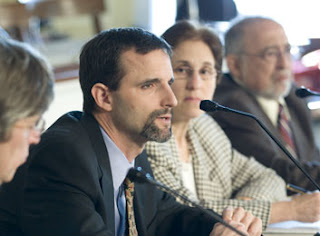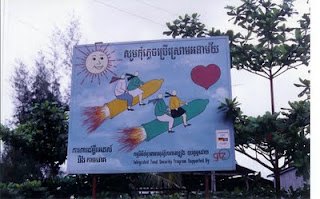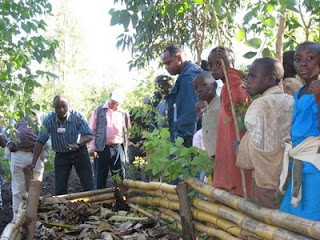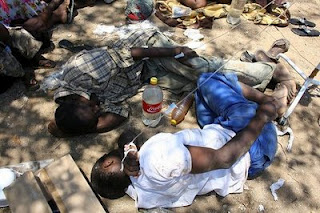-
Start With A Girl: A New Agenda For Global Health
›November 16, 2009 // By Calyn OstrowskiThe Center for Global Development’s latest report, Start With A Girl: A New Agenda For Global Health, sheds light on the risks of ignoring the health of adolescent girls. Like other reports in the Girls Count series, it links broad social outcomes with adolescent health. “Adolescence is a critical juncture for girls. What happens to a girl’s health during adolescence determines her future–and that of her family, community, and country,” state coauthors Miriam Temin and Ruth Levine.
Between childhood and pregnancy, adolescent girls are largely ignored by the public health sector. At the same time, programs and policies aimed at youth do not necessarily meet the specific needs of girls. Understanding the social forces that shape girls’ lives is imperative to improving their health.
Like recent books by Michelle Goldberg and Nicholas Kristof, the report argues for increased investment in girls’ education to break down the social and economic barriers that prevent adolescent girls from reaching their full potential. Improving adolescent girls’ health will require addressing gender inequality, discrimination, poverty, and gender-based violence.
“For many girls in developing countries, well-being is compromised by poor education, violence, and abuse,” say Temin and Levin. “Girls must overcome a panoply of barriers, from restrictions of their movement to taboos about discussion of sexuality to lack of autonomy.” The report points to innovative government and NGO programs that have successfully changed negative social norms, such as female genital cutting and child marriage. However, the authors urge researchers to examine the cost-effectiveness and scalability of these programs.
In the last five years, the international community has become increasingly aware of the importance of youth to social and economic development. Some new programs are focused on investing in adolescent girls, such as the World Bank’s Adolescent Girls Initiative and the White House Council on Women and Girls, but significant additional investment and support is needed.
“Big changes for girls’ health require big actions by national governments supported by bilateral and multilateral donor partners, international NGOs…civil society and committed leaders in the private sector,” maintain Temin and Levin. They offer eight recommendations:
1. Implement a comprehensive health agenda for adolescent girls in at least three countries by working with countries that demonstrate national leadership on adolescent girls.
2. Eliminate marriage for girls younger than 18.
3. Place adolescent girls at the center of international and national action and investment on maternal health.
4. Focus HIV prevention on adolescent girls.
5. Make health-systems strengthening and monitoring work for girls.
6. Make secondary school completion a priority for adolescent girls.
7. Create an innovation fund for girls’ health.
8. Increase donor support for adolescent girls’ health.
“We estimate that a complete set of interventions, including health services and community and school-based efforts, would cost about $1 per day,” say the authors of Start With a Girl. There is no doubt in my mind that this small investment would indeed have a high return for the entire global community. -
How Family Planning Meets Development Goals
› “Knowing is not enough; you must act and let your government know that family planning is a right and saves lives,” said Maurice Middleberg of the Global Health Council at a recent event in Chapel Hill.
“Knowing is not enough; you must act and let your government know that family planning is a right and saves lives,” said Maurice Middleberg of the Global Health Council at a recent event in Chapel Hill.
The other panelists at “How Can Family Planning Efforts Help Us Achieve the Millennium Development Goals?” (Dr. Martha Carlough of UNC, Dr. Ward Cates of Family Health International, and Pape Gaye of IntraHealth International) all provided compelling statistics demonstrating the effectiveness of family planning as an intervention that addresses the Millennium Development Goals (MDGs).
MDGs 4, 5, and 6 – reducing child mortality; improving maternal health; and combating HIV/AIDS, malaria, and other diseases, respectively – all have obvious connections to health and woman’s reproductive health. An unmet need for family planning, which is measured as the percentage of women of reproductive age who desire to space or limit their births but are not using contraception, can undermine the achievement of these goals.
For example, very early motherhood not only increases the risk of dying in childbirth, it also jeopardizes the well-being of surviving mothers—and their children, too. A child born to an adolescent mother has a greater risk of dying in infancy or childhood.
“Contraception is the best-kept secret in HIV prevention,” said Dr. Cates, who cited research that found that “current contraceptive use in sub-Saharan Africa prevents an estimated 577,200 unplanned births to HIV-infected mothers” and thus prevents the birth of an estimated 173,000 HIV-infected infants each year.
Family planning can help meet the other MDGs, including ending poverty and hunger (Goal 1); providing universal primary education (Goal 2); and promoting gender equity (Goal 3). Young mothers frequently miss out on education and socio-economic opportunities. Being able to make their own decisions about family planning and reproductive health can empower women and improve gender equity. When women are given equal opportunities for education, health, and employment, they are more likely to invest in the education and care of their children. This helps them break the cycle of poverty, hunger, and disease.
Although the MDGS don’t include any formal targets for sexual and reproductive health, the UN Millennium Project has stated that the MDGs cannot be achieved in low-income countries without access to sexual and reproductive health services, including family planning. The panelists agreed that family planning is a cost-effective intervention that provides broader positive benefits for development.
But the real strength of their presentations lay in the personal stories behind the statistics. Middleberg closed the discussion with a story about a woman in Latin America who told him that she loves her husband but was afraid of him every time he touched her. Now, after having undergone sterilization, she no longer worries and can love her husband with no fear of becoming pregnant.
A mother of six interviewed in a 2009 news article about the Philippines’ new family planning bill said, “How can one keep on having children? We don’t earn enough to feed them, much less send them to school.” New York Times columnist Nicholas Kristof interviews a Haitian woman with 10 children in a dramatic video interview, “Saving Lives with Family Planning.”
Underlying all of these facts and stories is the belief that one’s health and well-being, including access to family planning, is a right. But as Middleberg said, believing is not enough.
EngenderHealth, an international reproductive health organization working to improve the quality of health care in the world’s poorest communities, is asking Americans to create a video explaining why we should care about international family planning. Contribute your thoughts on YouTube’s Video Volunteers project.
Lisa Basalla, MPH, is a research associate with the Carolina Population Center. She graduated from Case Western Reserve University with a MPH focusing on reproductive and adolescent health. She has worked with Johns Hopkins University’s Center for Communications Programs on its reproductive health knowledge management project as well as a HIV-prevention behavior change communication project in Malawi.
Photo: A billboard promoting family planning in Phnom Pehn, Cambodia. Courtesy flickr user olerousing. -
Weekly Reading
›A Population Reference Bureau (PRB) policy brief considers several methods of integrating population, health, and environment initiatives in Uganda, citing the Ruhiira Millennium Village Project and the Conservation Through Public Health program as successful examples. Also new from PRB: Farzaneh (Nazy) Roudi explains that Iran’s “youth bulge, along with changes in women’s fertility and reproductive health, provide a backdrop for understanding Iran’s current political instability.”
In “Military vs. Climate Security: Mapping the Shift From the Bush Years to the Obama Era,” Miriam Pemberton of the Institute for Policy Studies compares U.S. government spending on climate change and military, arguing for dedicating more resources to climate security.
A new report from Global Witness reveals that all main warring parties in the eastern Democratic Republic of the Congo—including rebel groups and members of the Congolese national army—are heavily involved in the mineral trade in North and South Kivu provinces.
In the Spring 2009 edition of The New Atlantis, Kendra Okonski asks if water is a human right, while Travis Kavulla looks at “Aids Relief and Moral Myopia” in Africa, arguing that the Western public-health lobby “must realize that HIV has a social dimension that must be addressed.” -
Specialty Coffee Project Brings Jolt of Attention to Agriculture, Health in Rural Rwanda
›March 9, 2009 // By Rachel Weisshaar A landlocked, impoverished, densely populated country, Rwanda faces steep challenges in the quest to improve the quality of life of its people, who are mostly small-scale farmers. One solution promoted by the Sustaining Partnerships to enhance Rural Enterprise and Agribusiness Development (SPREAD) project, which I visited last month with the leaders of the East Africa Population-Health-Environment (PHE) Network, is helping farmers produce higher-quality crops, which can be sold for premium prices on international markets. In this way, farmers can increase their income by producing better crops, rather than producing more—since in Rwanda, there isn’t any more land to go around.
A landlocked, impoverished, densely populated country, Rwanda faces steep challenges in the quest to improve the quality of life of its people, who are mostly small-scale farmers. One solution promoted by the Sustaining Partnerships to enhance Rural Enterprise and Agribusiness Development (SPREAD) project, which I visited last month with the leaders of the East Africa Population-Health-Environment (PHE) Network, is helping farmers produce higher-quality crops, which can be sold for premium prices on international markets. In this way, farmers can increase their income by producing better crops, rather than producing more—since in Rwanda, there isn’t any more land to go around.
Coffee is Rwanda’s primary export, so SPREAD focuses its efforts there, although it also targets other high-value crops like chili peppers. SPREAD helps organize farmers into cooperatives with their own bylaws and elected leaders; for instance, the highly successful Maraba cooperative includes 1,400 farmers and their families. Agricultural extension agents show farmers techniques for raising the quality of their coffee. One innovation SPREAD has introduced is coffee bikes, which are specially designed eight-speed mountain bikes that can carry up to 300 kg of coffee cherries. SPREAD found that coffee transported to processing stations on the bikes scored 3.5 SCAA quality points higher than coffee transported by foot or truck, due to shorter average times between harvesting and processing.
SPREAD has provided the impetus for the construction of 120 coffee washing stations (CWS) during the past several years, and has also set up three CWS support centers, which assist with quality control. Washing coffee before and after fermentation is key to preserving its quality. SPREAD has made sure to incorporate a number of environmental initiatives into coffee growing and processing, including mulching coffee trees and digging trenches around them to prevent erosion on Rwanda’s steep hillsides; purchasing new water-efficient coffee-washing machines; filtering the CWS wastewater before releasing it into the river; and using vermiculture (worms) to process coffee pulp and mucilage into organic fertilizer. As SPREAD’s Jean Marie Irakabaho put it, growing coffee without caring for the land is like milking a cow without feeding it.
SPREAD has incorporated family planning (FP) and health initiatives into its agricultural work. The same coffee extension workers who teach farmers how to improve the quality of their coffee have been trained to deliver basic health and FP messages and products to them. Working closely with the district government and local health center, SPREAD staff focus primarily on improving maternal and child health; FP; HIV/AIDS prevention, testing, and treatment; and water, sanitation, and hygiene. A weekly radio program, “Imbere Heza” (“Bright Future”), integrates coffee-growing and health information.
SPREAD, which is funded by the U.S. Agency for International Development and led by the Norman Borlaug Institute for International Agriculture at Texas A&M; University, knows it won’t be around forever, so it is striving to make its improvements to Rwandan livelihoods permanent. It created the Rwanda Small Holder Specialty Coffee Company (RWASHOSCCO), a cooperative-owned company that helps cooperatives market and export their coffee. Specialty Rwandan coffee can now be found in online stores like Land of a Thousand Hills Coffee and Allegro Coffee, as well as in cafes around the world. At the East Africa PHE Network workshop, our coffee breaks featured wonderful coffee from the Maraba cooperative. I encourage all coffee connoisseurs to taste for themselves the delicious results of sustained investment in the livelihoods, agriculture, environment, and health of Rwanda’s coffee farmers!
Rachel Weisshaar attended the meeting of the East Africa PHE Network in Kigali, Rwanda. See previous posts on the New Security Beat: “Rwanda: More Than Mountain Gorillas,” “East Africa PHE Network: Translating Strong Results Into Informed Policies,” and “East Africa Population-Health-Environment Conference Kicks Off in Kigali.”
Photo: Jean Marie Irakabaho (left), chief agronomist and coffee research coordinator at SPREAD, shows the beds where worms are being raised to digest coffee pulp and mucilage, while local children look on. Courtesy of Rachel Weisshaar. -
Global Public Health: An Agenda for the 111th Congress
›February 11, 2009 // By Gib Clarke This is an exciting time to be working global public health, with more attention and money going to the field in the last decade than perhaps ever before. In the past, the struggle has been to direct more money and attention to these issues, but recent efforts have focused more on maximizing funds’ impact—by strengthening health systems, focusing on prevention, and finishing so-called “unfinished agendas” in maternal health, child mortality, and family planning. In my remarks at a recent panel on foreign policy challenges facing the 111th Congress, I focused on four issues: infectious diseases, neglected health issues, funding, and capacity building.
This is an exciting time to be working global public health, with more attention and money going to the field in the last decade than perhaps ever before. In the past, the struggle has been to direct more money and attention to these issues, but recent efforts have focused more on maximizing funds’ impact—by strengthening health systems, focusing on prevention, and finishing so-called “unfinished agendas” in maternal health, child mortality, and family planning. In my remarks at a recent panel on foreign policy challenges facing the 111th Congress, I focused on four issues: infectious diseases, neglected health issues, funding, and capacity building. -
Could Threat of Regional Cholera Pandemic Finally Topple Zimbabwe’s Mugabe?
›December 23, 2008 // By Rachel Weisshaar
Zimbabwe’s current cholera epidemic has killed more than 1,100 people and sickened nearly 24,000, prompting the United States, the United Kingdom, and some African nations to press for sanctions on—and the resignation of—President Robert Mugabe. The impoverished country ranks 151 out of 177 on the UN Human Development Index and has an average life expectancy of 34 for women and 37 for men. Although it has suffered yearly cholera outbreaks since 1998, this year’s epidemic dwarfs previous ones. The epidemic is being aggravated by severe food shortages and the country’s high prevalence of HIV/AIDS, and is expected to continue through the end of the rainy season in March.
-
Weekly Reading
›In “Who Cares About the Weather?: Climate Change and U.S. National Security” (subscription required), Joshua Busby argues that although advocates have overstated some of climate change’s impacts, it nevertheless poses direct threats to conventional U.S. national security interests, and therefore deserves serious consideration by both academics and policymakers.
An article in the Economist examines the melting Kolahoi glacier, which could soon threaten water supply and livelihoods in the Kashmir valley.
“Marauding elephants in northern Uganda have added to the challenges faced by civilians trying to rebuild their lives in the wake of 20 years of civil war, destroying their crops and prompting some to return to displaced people’s (IDP) camps they had only recently left,” says an article from IRIN News.
In an EarthSky podcast interview, Lori Hunter of the University of Colorado, Boulder, discusses her work researching how HIV/AIDS affects families’ use of natural resources.
Payson Schwin of the World Resources Institute recently interviewed Crispino Lobo of the Watershed Organization Trust about his work helping rural Indian villages escape poverty by managing their natural resources sustainably.
A research commentary from Population Action International explores family planning trends in Pakistan, as well as the relationships between demography and security in this critically important country.
Despite—or perhaps because of—its extremely high population density, Rwanda has launched a series of initiatives to protect its environment and reduce poverty, reports the UN Food and Agriculture Organization.
The Population Reference Bureau has released two new policy briefs examining population, health, and environment issues in Calabarzon Region and the Autonomous Region of Muslim Mindanao.
Stalled Youth Transitions in the Middle East: A Framework for Policy Reform proposes changes to education, employment, and housing that would offer Middle Eastern youth additional opportunities. “Young people in the Middle East (15-29 years old) constitute about one-third of the region’s population, and growth rates for this age group are the second highest after sub-Saharan Africa,” say the authors. “Today, as the Middle East experiences a demographic boom along with an oil boom, the region faces a historic opportunity to capitalize on these twin dividends for lasting economic development.”
An October 2008 brief from the UN Department of Economic and Social Affairs uses examples from Africa and Latin America to explore ways to ensure that non-renewable resource revenues contribute to sustainable development.
Video is now available for “Breaking Barriers: Family Planning, Human Health and Conservation,” a session at this month’s Conservation Learning Exchange conference in Vancouver. -
PEPFAR Boon to U.S. National Security, Says Senator Richard Lugar
›July 17, 2008 // By Jackson DroneyIn a rare display of bipartisan unity, the U.S. Senate voted 80-16 Wednesday to reauthorize the President’s Emergency Plan for AIDS Relief (PEPFAR). Originally passed in 2003 and set to expire this September, the White House credits PEPFAR with delivering antiretroviral drug treatment to 1.7 million people worldwide.
Reflecting the bipartisan support of the program, the top two members of the Senate Foreign Relations Committee heaped praise on the program and the president. Senator Joseph Biden (D-DE), chairman of the committee, said the program is “the single most significant thing the president has done.” Senator Richard Lugar (R-IN), the committee’s ranking member, argued eloquently that PEPFAR benefits U.S. national security and foreign policy. During the floor debate, he made the following statement:We should understand that our investments in disease prevention programs have yielded enormous foreign policy benefits during the last five years. PEPFAR has helped to prevent instability and societal collapse in a number of at-risk countries; it has stimulated contributions from other wealthy nations to fight AIDS; it has facilitated deep partnerships with a new generation of African leaders; and it has improved attitudes toward the United States in Africa and other regions.
The Senate legislation extends the program five years and triples its funding to $48 billion. The bill met with initial opposition from several conservatives, and the Democratic-controlled Senate defeated several Republican amendments earlier this week. The House passed a slightly different version of the legislation in April; differences between the two bills will be resolved in a conference committee.
In my judgment, the dollars spent on this program can be justified purely on the basis of the humanitarian results that we have achieved. But the value of this investment clearly extends to our national security and to our national reputation.
Showing posts from category HIV/AIDS.


 “Knowing is not enough; you must act and let your government know that family planning is a right and saves lives,” said Maurice Middleberg of the Global Health Council at a recent
“Knowing is not enough; you must act and let your government know that family planning is a right and saves lives,” said Maurice Middleberg of the Global Health Council at a recent  A landlocked, impoverished, densely populated country, Rwanda faces steep challenges in the quest to improve the quality of life of its people, who are mostly small-scale farmers. One solution promoted by the Sustaining Partnerships to enhance Rural Enterprise and Agribusiness Development (
A landlocked, impoverished, densely populated country, Rwanda faces steep challenges in the quest to improve the quality of life of its people, who are mostly small-scale farmers. One solution promoted by the Sustaining Partnerships to enhance Rural Enterprise and Agribusiness Development (


